About Pads | ||||||||
|
| |||||||
Creating a Pad
Creating a pad means extruding a profile or a surface in one or two directions. The application lets you choose the limits of creation as well as the direction of extrusion.
By default, the application extrudes the profile normal to the plane used to create the profile. To see how to change the extrusion direction, see Creating Pads not Normal to Sketch Planes
If you extrude a surface, you need to select an element defining the direction because there is no default direction.
![]()
Pad Definition Dialog Box
This section describes the various options available in the Pad Definition dialog box to create a pad.
In this dialog box, you can define a pad using these options:
Type
By default, the application specifies the pad's length (Type= Dimension option). Here are the different types of limits you can set:
- Dimension.
- Upto to next : The application detects
existing material for trimming the pad.
Profile
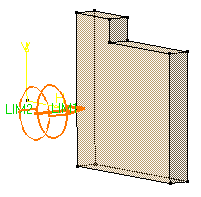 Result
Result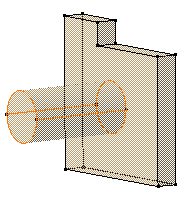
- Up to last: The last face encountered
by the extrusion trims the pad.
Profile
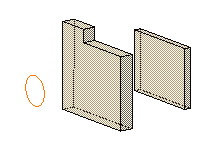 Result
Result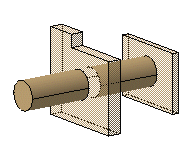
- Up to plane: The selected plane trims the extrusion.
- Up to surface: The selected
surface trims the extrusion.
Profile
 Result
Result
If you set Up to plane or Up to surface, the Offset box becomes available to let you define an offset from the selected plane or surface.
If you set Up to plane, contextual commands creating new planes you may need are then available from the Limit box:
- Insert Wireframe > Create Plane: For more information, see Generative Shape Design User's Guide: Creating Wireframe Geometry: Creating Planes.
- Insert Wireframe > XY Plane: The XY plane of the current coordinate system origin (0,0,0) becomes the limit.
- Insert Wireframe > YZ Plane: The YZ plane of the current coordinate system origin (0,0,0) becomes the limit.
- Insert Wireframe > ZX Plane: The ZX plane of the current coordinate system origin (0,0,0) becomes the limit.
If you set Up to surface, contextual commands creating new surfaces you may need are then available from the Limit box:
- Insert Operations > Create Join: Joins surfaces or curves. For more information,see Generative Shape Design User's Guide: Performing Operations on Shape Geometry: Joining Surfaces or Curves.
- Insert Operations > Create Extrapol: Extrapolates surface boundaries. For more information, see Generative Shape Design User's Guide: Performing Operations on Shape Geometry: Extrapolating Surfaces.
If you create any of these elements, the application then displays the
corresponding icon in front of the box. Clicking this icon enables you to
edit the element.![]()
If you have chosen to work in a hybrid design environment, the elements created on the fly via the contextual commands mentioned above are aggregated into sketch-based features.
Thick
The Thick option adds thickness to both sides of your profile. To know how to use it, see Creating Thin Solids.
Reverse Side
The Reverse side button applies for open profiles only. This option lets you choose which side of the profile is to be extruded. When designing Creating Thin Solids, the option is meaningless.
![]()
About Profiles
This section provides information on the profiles used to create a pad.
You can:
-
Use profiles sketched in the Sketcher workbench or planar geometrical elements created in the Generative Shape Design workbench (except for lines).
-
Select diverse elements constituting a sketch. For more information, see Using the Sub-Elements of a Sketch.
- If you execute the Pad command with no profile previously
defined, just click the
 icon
available in the dialog box. You then just need to select a sketch plane
to enter the Sketcher workbench and then create the desired profile.
As soon as you click
icon
available in the dialog box. You then just need to select a sketch plane
to enter the Sketcher workbench and then create the desired profile.
As soon as you click
 , the
Running Commands window
is displayed to show you the history of commands you have run. This
informative window is particularly useful when many commands have already
been used, in complex scenarios for example.
, the
Running Commands window
is displayed to show you the history of commands you have run. This
informative window is particularly useful when many commands have already
been used, in complex scenarios for example.


- Select Generative Shape Design surfaces, non-planar faces and even V4 surfaces. For more information, see Creating Pads or Pockets from Surfaces.
-
If you are not satisfied with the profile you selected, note that you can:
-
Use any of the following creation contextual commands available from the Selection box:
-
Insert Wireframe > Create Sketch: Opens the Sketcher workbench after selecting any plane, and lets you sketch the profile you need as explained in the Sketcher User's Guide.
-
Insert Surfaces > Create Fill: Creates fill surfaces between the boundary segments. For more information, see Generative Shape Design User's Guide: Creating Surfaces: Creating Fill Surfaces.
-
Insert Operations > Create Join: Joins surfaces or curves. For more information, see Generative Shape Design User's Guide: Performing Operations on Shape Geometry: Joining Surfaces or Curves.
-
Insert Operations > Create Extract: Generates separate elements from non-connex sub-elements. For more information, see Generative Shape Design User's Guide: Performing Operations on Shape Geometry: Extracting Geometry: Extracting Elements.
-
-
-
If you have chosen to work in a hybrid design environment, the geometrical elements created on the fly via the contextual commands mentioned above are aggregated into sketch-based features.

-
Clicking Sketch
 opens the Sketcher workbench in which you can then edit
the profile . Once you have done your modifications,
you just need to exit the Sketcher workbench. The Pad dialog box then
reappears to let you finish your design.
opens the Sketcher workbench in which you can then edit
the profile . Once you have done your modifications,
you just need to exit the Sketcher workbench. The Pad dialog box then
reappears to let you finish your design.
![]()
More About the Pad Command
This section provides information on the Pad command.
Keep in mind the following when using Pad
![]() .
.
- The application allows you to create pads from open profiles provided
existing geometry can trim the pads.
The pad below has been created from an open profile which both endpoints
were stretched onto the inner vertical faces of the hexagon. The option
used for Limit 1 is Up to next. The inner bottom face of
the hexagon then stops the extrusion. Conversely, the Up to next
option could not be used for Limit2.
Profile
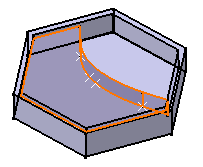 Result
Result
- You can also created pads from sketches including several profiles.
These profiles must not intersect.
In the following example, the sketch to be extruded is defined by a
square and a circle. Applying the Pad command on this sketch
lets you obtain a cavity :
Profile
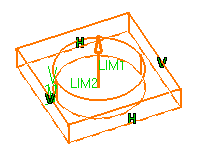 Result
Result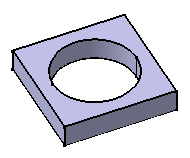
However, if the application can generate an intersection between both profile endpoints, it produces a pad as in the following example. The profile chosen is an arc of circle. Although no existing geometry can trim the pad to be created, the application succeeds in generating a pad.
Profile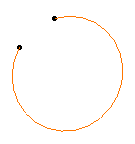 Result
Result
![]()
Copying and Pasting a Pad
You can copy and paste a pad using the As specified in Part document option.
When copying and pasting a pad using the As specified in Part document option (for more information, see Handling Representations in a Multi-Representation Environment, if the extrusion direction used does not belong to the same body as the pad, this direction is not taken into account by the Copy and Paste commands.